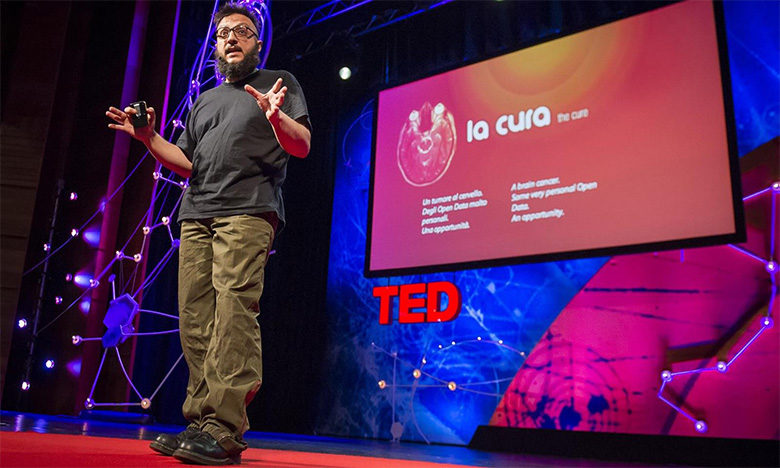Salvatore Iaconesi was studying for his Ph.D. in robotic engineering when he “had a little crisis.” The technology behind everything he designed — from toys to self-assembling robots to intelligent control systems — was being used, directly or indirectly, to kill people, he realized. But “that’s robotics,” he sighs, decrying the presence of the military in both initiating and poaching any technological development in the sector. It was the kind of protest musing of an artist, which is indeed his chosen profession today. But there’s not a paintbrush in sight: Iaconesi’s art is about creating unique demonstrations of our increasingly digital lives.
Iaconesi is neither a pessimistic naysayer decrying the alienation of modern life nor a Pollyanna-ish futurist. Skyping from over 6,000 miles away, the 43-year-old Italian tells me technologies provide both opportunities and threats; a hammer can build a house or smash a brain in. Iaconesi, along with his wife and creative soul mate, Oriana Persico, explores how people can achieve freedom, dignity and connection in an increasingly technological universe. Their longest-running brainchild, Art Is Open Source, collects the array of projects, performances and installations that they and a community of like-minded artists have toured around Europe and beyond. One such project, Enlarge Your Consciousness, used a language analysis program to display the emotions of social media users using color and sound, and allowed participants to access the interface long after the exhibition, connecting people to the emotions of a stranger in real time. In Squatting Supermarkets, smartphone owners leave one another messages via
an augmented-reality depiction of a supermarket aisle. (This, Iaconesi says, is an exercise in reclaiming an ad-drenched space where people usually cannot control what they see.)
“It is very hard to understand where art and design end and where technology and the sciences begin” in his work, says Iaconesi, who describes himself as an engineer and philosopher by training and an artist and hacker by nature. “Everything is very mixed up and we like it this way.” The same is true for the artistic duo. “There is no separation between love and work, art and research” for the pair, says Persico.
"HACKING IS NOT ABOUT TECHNOLOGIES; HACKING IS A STATE OF MIND."
Iaconesi describes his work with occasionally bewildering grandiosity, employing phrases like “repositioning ubiquitous technologies.” But he does practical work too: He and Persico run a design studio and teach at ISIA University in Florence, as well as running a U.K.-based organization that runs digital visualizations for cities’ social networks. Art and other creative practices are important to allow people to understand the rapidly changing world they live in, says Dr. Mark Coté, a digital culture and big data lecturer at King’s College London, who has worked with Iaconesi and Persico on a number of projects.
The rise of big data and the “datafication” of everything from our consumption habits to our social interactions means that personal data follows us wherever we go, says Coté, and yet an “asymmetry of access” persists. One exhibition for which he collaborated with the twosome, Persona Non Data, sought to rebalance that power dynamic. It “hacked” into a gallery’s CCTV system and public Wi-Fi network; upon leaving the exhibition, participants saw how the cameras identified people, tracked their movements and even glimpsed their internet browsing. Nearly 30,000 people participated over two months.
In 2012, Iaconesi turned his hacking on himself when he was diagnosed with brain cancer — a stage 2 malignant glioma. He discharged himself from the hospital against medical advice in order to request access to his own medical records. He got them, but still had to hack to make them readable on nonspecialist computers. He claims he “open-sourced” the cure for his cancer by publishing the details of the tumor on the web. The project, titled La Cura — the cure — “was never about finding a miracle cure from some guru in the Himalayas, it was about the integration of what can be called a cure,” he says. Medical experts reached out, recommending particular treatments, while poets, artists, designers and cancer survivors addressed the emotional elements of his experience, offering a “social cure” too, he says. La Cura remains online (in Italian); an English translation in book form is forthcoming. He and Persico are now exploring ways to extend this approach to other social problems in areas such as agriculture and education.
Of course, hacking raises ethical questions. While Iaconesi decries the fact that his vital stats reached others’ eyes only, doctors emphasize that patients becoming faux-Google doctors could cause them to jump to the wrong conclusions, or fall victim to quack advice. It’s possible Iaconesi’s projects remind the medical profession of its ongoing conversation about how to better involve patients in their own treatments.
Iaconesi is now cancer-free: The shaved back and sides of his head surrounding the thick tuft of black hair on top reveal a scar where his tumor was surgically removed. Persico sports the same quirky haircut. La Cura changed Iaconesi “in enormous ways,” he says, making him feel more connected to all who reached out to him and the wider world. It’s now “increasingly difficult to decide where ‘me’ ends,” he says.

